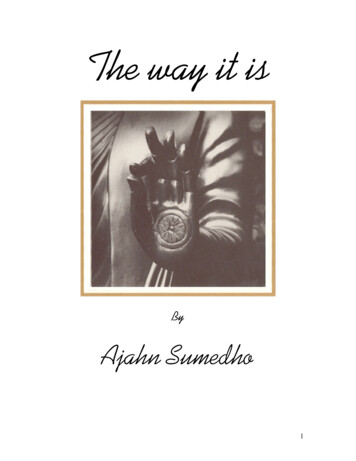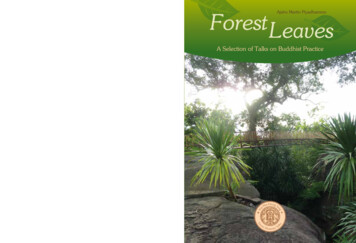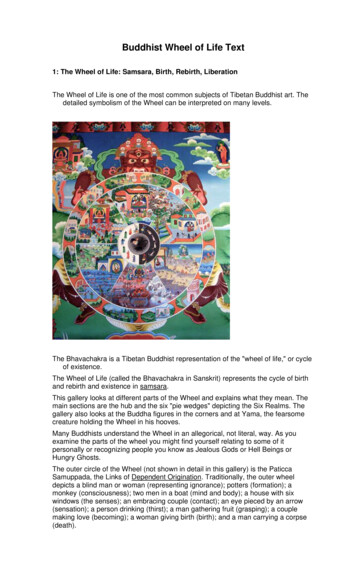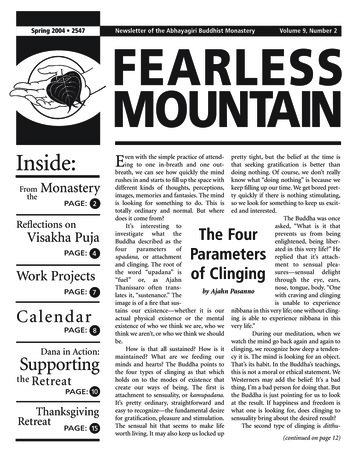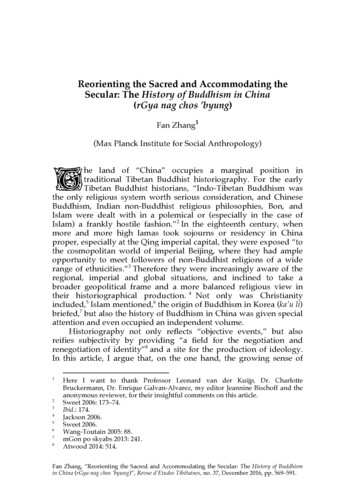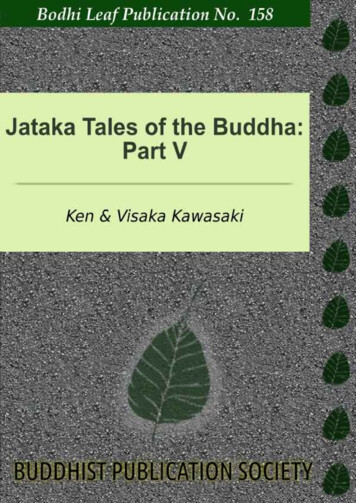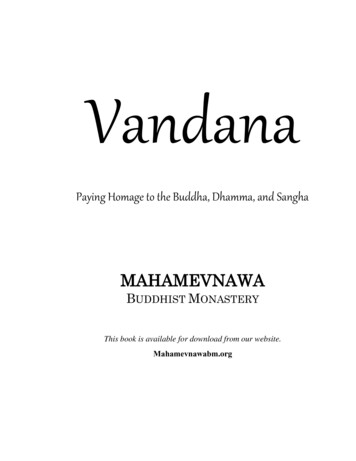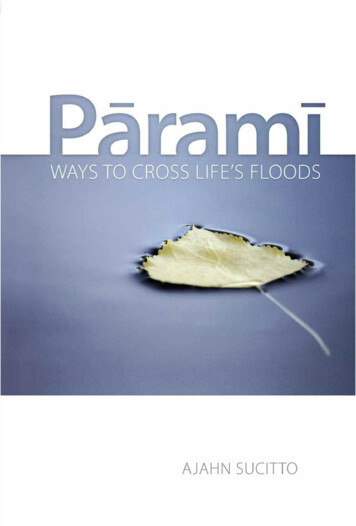
Transcription
AJAHN SUCIT TO
Bhikkhu Sucitto and Amaravati PublicationsAmaravati,Great GaddesdenHemel Hempstead HP1 3BZUKThis book is offered for free distribution.We would like to acknowledge the support of many peoplein the preparation of this book and especially to theKataññuta group of Malaysia, Singapore and Australiafor bringing it into production.This book is also available for free download fromwww.forestsanghapublications.org2012 Amaravati PublicationsISBN: 978-1-870205-59-7For permission to reprint and general enquiries, contact:abmpublications@amaravati.orgThis work is licensed under the Creatice Commons Atribution-NonCommercial-NoDerivs2.0 UK: England & Wales License. To view a copy of the license, 2.0/ukSee page 224 for more details on your rights and restrictions under this license.Cover image ‘Yellow leaf on blue water’ snoron.com‘Leaf ’ text divider image photo Nicholas HallidayCover and book design by Nicholas HallidayFirst edition, 10,000 copies, printed in Malaysia 2012
TouchingtheEarthENTURIES AGO a seeker, one who searches for a way beyondbirth and death, was wandering through a remote valley of one of the manytributaries of the Ganges river. He had been wandering for six years and in thecourse of that time had studied under teachers, developed meditation andstrengthened his considerable resolve.Most recently he had been part of a group of six ascetics whose view was thatthe way to liberation opened through disregarding or suppressing the senses.Eating solid food was to be done begrudgingly, if at all; the body was to bechastised and its needs given no attention. In this, as in all his previous spiritualdisciplines, the seeker excelled his companions. And yet he knew that he hadattained no superior state and gained no liberating wisdom.At this critical point, reduced to a scrawny creature of little more than flakingskin and bone, he had left the group to intensify his practice in solitude. Finallyhe found a grove of trees and took up the sitting position at the root of a figtree, determined to sit in full awareness, mind bent on investigating whatevermight arise in his consciousness. His aim was to see if there could be a waythrough the shifting manifestations of thoughts, sensations and emotions — todiscover whether there was some absolute and untrammelled state. Yet as hetried to apply himself, he found that his body was now too weak to even sustainsitting upright. Nor was his mind steady and clear.Strained and driven only by willpower, it could neither open nor settle into calm;instead his mind formed voices that whispered in his inner ear, some accusing,some mocking. Strange visions flittered through the shifting veils ofconsciousness. He was unable to repel or investigate them. A despondent inertiahovered over him like a vulture.There were some slight sounds and a quiet voice that, at first, barely made animpression on his mind. Groggy as he was, his awareness still sensed a shift inthe gloom of his near-death state. Pulling apart the eyelids which had gluedshut, he made out the form of a young woman, kneeling in front of him with a
dish. ‘Sujata asks for your blessing, noble one!’ she said gently as she laid thedish in front of him. ‘Please partake of my offering so that my generosity can befulfilled!’ He moved his lips, but his throat could not form words. Yet, herkindness touched chords in his heart and a sense that had been ignored foryears stirred. Before he could form a thought, his head had made a movementof assent and one skinny hand had lifted in response. Sujata smiled andwithdrew, and while allowing the natural instinct to move through him, theseeker found himself carefully scooping a meal of sweet milk rice from the dish,one slow mouthful at a time, until he had consumed it all.Life flowed through his system like the sap that fed the tree under which he sat.‘Why not?’ he thought. ‘Let Nature look after nature. What good is there infighting against its laws? Why not let it support me in this quest?’ With his bodyrefreshed and his mind clearing from its near-death delirium, he sat cross-leggedand upright under the canopy of the tree and steadied his awareness on theexperience of breathing in and out. It suddenly occurred to him that when hewas a child he had done just that, quite spontaneously, and it had taken him toa place of natural calm. Eagerly, he picked up the theme.Evening came and with it shadows, and the sounds of the many animals thatmove through the night. Sensing this, the seeker’s mind entered its own deepshadows and all that lurks there. Fear and uncertainty arose, followed by aprocession of moods — apathy, craving and negativity amongst many othersswelled into a veritable army attacking his resolve. Boredom, sense desire,drowsiness and passions beset him as he sat there, hour after hour. And yet,now on guard against every inner voice as well as against forcefully suppressingthem, he continued to sit firm and upright in full awareness. The nightprogressed while the power of these energies seemed to crystallize into onegreat, raging force. It was like a demon battering and tugging him. And it sweptinto the depths of his heart, where he could hear its seductive whispering:‘Why sit here under a tree at night alone, wasting your youth? How can anythinggood come of this painful and impotent sojourn? Why not trust life, learn as yougo through its joys and marvels and challenges? It’s late, take a rest and seewhat the morning brings.’The seeker unified his mind around his resolve and looked for a clear response.Eventually, one came. ‘I know you, demon; you’re Mara, the deceiver, the voiceof Death! You’re the one who has kept me chasing delusions and running fromshadows through life after life and death after death. This time, I’m not budging.You won’t shift me with your doubts and promises.’‘You know nothing and you’ll get nothing out of sitting here. Death will sweepyou away like a twig in a flood!’ said Mara. ‘And even before that comes, I can
call on forces of fear, loneliness and longing that will drive you to despair andsend you running for comfort. You just have one feeble body and a heart awashwith confusion. How do you think that your sitting still is going to conquer me?’‘My body is mortal, but I’m not relying on that. My heart may sense fear andcraving, but I’m not taking a stand on that. I have an inheritance of many livesspent in working for purity, both of conduct and of mind. And sitting still, alone,unarmed, I also can command a tide that will check your flood! I stand on beingat peace with whatever arises. Here, now, I call this very Earth to witness that Iam ready, ripe with all the perfections that are needed to sweep you and yourdemon host out of my heart.’ With these words, the seeker focused his attentiondeep within his embodied awareness. In that calm centre beneath personality,thoughts and moods, he touched into a rich ground.A response was not long in coming. His firmness grew as he recollected thehuge store of virtues and resolves that he had enacted over many lives; and inhis mind’s eye, the very spirit of the Earth rose up like a goddess. Wrapping herlong hair into a braid, she twisted it — and wrung out of it a great fountain ofwater that swept through the darkness of the grove . His heart brimmed withconfidence and clarity radiated around him: Mara and his entire host haddissolved like mist at dawn.After allowing the clarity and joy to wash their refreshing tides through him, theseeker resumed his introspection. He began recalling the results of acts basedon kindness, patience, resolve and more, the deeds of many lifetimes. Hereviewed the processes that determine everyone’s life, the pressure, turmoiland pain that accompanied them — and finally how they can be put to rest. Bythe time that dawn had arisen, a deep unshakeable peace had settled withinhim: he had discovered the release from the grip of Death.In years to come, many people who heard his teachings came to acknowledgethe profundity of his realization. Sensing his deep clarity and mastery of mind,they called him ‘Buddha’ — the Full-Knowing, the Enlightened, the Awake.
ContentsPreface by KittisaroAuthor’s Preface and AcknowledgementsCrossing the Floods15Quotes and Suggestions on Heedfulness1125Quotes and Suggestions on GenerosityQuotes and Suggestions on Morality314650Quotes and Suggestions on Renunciation5568Quotes and Suggestions on Wisdom7388Quotes and Suggestions on Energy93108Getting on Board for LiberationLetting GoInnate ClarityStewarding Resources
Bearing with Life113The Fullness of TruthQuotes and Suggestions on Truthfulness133148Quotes and Suggestions on Resolve153167Quotes and Suggestions on Kindness171185Quotes and Suggestions on Equanimity191203Quotes and Suggestions on PatienceResolveHolistic KindnessEvenness of MindClosing: Bringing It HomeGlossary128209213
Preface by KittisaroI am delighted to write a short preface for this excellent andimportant book on pāramī, the essential qualities of heart thatcarry us safely through the swirling floods of existence to theunshakeable groundedness and well-being of our true nature. Thepublication of this work brings to joyful fruition an idea I hadseveral years ago. Ajahn Sucitto has visited Thanissara and me inSouth Africa many times over the years, always taking a realinterest in our Dharma work, encouraging us and regularlyoffering accessible teachings to help our fledgling communityof practitioners negotiate the turbulent currents of a postapartheid society.We arrived in this country in November 1994 in response to ateaching invitation. Some of our friends warned, ‘Don’t go there.It will be a bloodbath.’ Trusting that to teach meditation washarmless, wholesome and relatively blameless, Thanissara and Ibrushed aside the dire predictions and made the journey. The planwas to lead a series of retreats, tour around a bit in a beautiful landundergoing an historic transition and go home. That would bethat. We had no idea what we were getting into. We ended upimmigrating, a decision that would drastically change our livesand transform our notion of Buddhist practice.In the early years of our residency, we led many retreats at themain meditation centre in Ixopo, and began to develop ahermitage in the mountains called Dharmagiri. ImaginingDharmagiri as a place of long, uninterrupted silent rejuvenatingretreats, we were shocked to meet the reality of frequent knockson our door — people needing money; someone dead at the gate,1
a need for a vehicle to transport the body; so many beingssuffering from dreadful illness with no proper medicine; childrenwanting education; schools lacking basic necessities like runningwater and electricity; young men bleeding from a fight urgentlyneeding a doctor. It was overwhelming. We were regularly floodedinternally and externally with helplessness, exhaustion,resentment, yearning, hopelessness and despair. To survive andbe relevant, we soon realized our spiritual practice had to stretchbeyond meditative calm to include and embrace the surroundingfield of great need and suffering.When I first heard Ajahn Sucitto’s original taped talks on thepāramī, I rejoiced in their clarity and incomparable applicabilityto living skilfully in the world. They present a path of practice thatgathers in all that we think, say and do — a Way that isn’t limitedto meditation techniques or lofty notions of transcendence. Evenwith a noble, wise and charismatic leader like Nelson Mandela,with his visionary example of forgiveness and reconciliation, thepeople of South Africa, it seemed to us, were still traumatized byapartheid, and carried deep fundamental wounds in theunderlying fabric of the culture. The natural expressions of basichuman generosity, care and compassion seemed to be obstructedand damaged. Mandela’s heroic example made a peacefultransition possible. He blessed us and pointed the way, but asindividuals, we still needed to do the diligent work oftransformation. Many people of all the diverse colours and racesliving here are still suffering.The systematic teachings on the pāramī, the gradual building ofthe ‘temple of awareness’ that Ajahn Sucitto eloquently describesin this book, throws a precious lifeline to the isolated,overwhelmed beings that we all recognize in ourselves from timeto time. If we hold it true, it will guide us back home to solidground and a renewed sense of community.2
Most of us frequently experience the feeling of being swept way.These powerful teachings enable us — in moments — to emergefrom the flood into the ever-present brightness and stability ofthe unobstructed heart. The Ten Perfections offer a spiritualitythat is holistic. The Buddha’s teaching envisions well-being on alllevels, within and without. In today’s world filled with so muchinequality, injustice, suffering and conflict, these human virtuesremind us that we are not isolated beings. We live in a relationalfield, and the realization of true peace is not just about letting goof the world, but rather living mindfully — remembering — andhealing the world.When I originally asked Ajahn Sucitto if we could put his talks intoa book, I wanted South Africans to help make a gift of Dharma,hoping that the wonderful blessings of these teachings would intime shower back on this emerging rainbow nation, bringinglasting harmony, clarity and grand-heartedness to thisextraordinary land.Now this dream is coming true. May all beings from all countriesfind these teachings useful. May they carry us across the floods tothe end of suffering.KittisaroDharmagiri Drakensberg Mountains 20113
Author’s Preface and AcknowledgementsThis book originates in a series of talks I gave at CittavivekaMonastery in the mid-1990s. More than a decade later, Kittisaroarranged to have them transcribed and edited with the intentionthat they be published in a readable form. Since receiving thedraft, I have substantially rearranged, edited and added to thematerial. This is because the talks were given to the residentmonastic community who already had a lot of backgroundknowledge that I can’t assume the reader has. Also my understanding has grown over time, and I wanted to back up the originalmaterial with references to the Suttas of the Pāli Canon, and alsowith advice on the daily practice of pāramī. This latter is now inthe sections entitled ‘Quotes and Suggestions on ’ My wish is thatthe mixture of colloquial and more academic sections present abalanced guide for ongoing Dhamma practice. For people whoapproach Dhamma through meditation, I would recommendgiving consideration to the processes of ‘Reflection’ and ‘Action’;these are traditional standards which help to bring Dhamma intothe more engaged and external focus outlined by the pāramī.As this is not a handbook on meditation, the guidance marked‘Meditation’ is mostly about how one establishes meditationpractice on the foundations of right view and right action. It mayseem basic, but foundations are like that; nevertheless, goodfoundations make all the difference to what comes later.The translations of the material from the Pāli Canon are heavilydependent on the good work of Bhikkhus Nyānamoli, Bodhiand Thānissaro, whose translations can be read in the5
Wisdom Publications editions of the Sutta Pitaka, and viawww.accesstoinsight.org respectively. I have consulted a range oftranslations to feel sure of the essential meaning and madeadaptations in the language to suit the requirements of brevityand accessibility. The farthest I’ve strayed away from the originalis in rendering ‘morality is the ford of the Buddhas’ (Theragātha613) as ‘morality is the way that Buddhas cross the floods.’ This isbecause whereas to a contemporary of the Buddha the term ‘ford’would bring up resonances of the Jain saints, the ‘Tirthankara,’ or‘those who make a ford across the flood of human misery,’ thisimage might be obscure to a contemporary reader.This project only could have been undertaken and reached fruitionthrough the support and skills of many people. Kittisaro,Thanissara and friends in South Africa initiated the project;Durten Rohm made the transcriptions, and Judy Tobler andChantel Oosthuysen did the preliminary editing. Another goodfriend, Dorothea Bowen in USA, then polished the draft after I hadmade my changes to it. In the UK, Nicholas Halliday designed andtypeset the book. Finally, Dhamma-practitioners in Malaysiasponsored the production of the book for free distribution. Suchis the blessing of a global community. I trust that the reader willjoin me in offering our gratitude and acknowledgement of theirgood and generous actions.Ajahn SucittoCittaviveka 20116
Quotes are fromthese collections inthe Pāli CanonADhpItiMSSnpThagNumerical Discourse/Gradual SayingsDhammapadaItivuttakaMiddle Length SayingsCollected Discourses/Kindred SayingsSutta NipātaTheragātha (Elders’ Verses)9
Crossing the FloodsA way of talking about transcendence, liberation or however youconceive of a spiritual path, is to use the metaphor of ‘crossing thefloods.’ Interest in deep change gets triggered by the feeling ofbeing swept along by events; by the sense of being overwhelmedby, and even going under, a tide of worries, duties and pressures.That’s the ‘floods.’ And crossing them is about coming through allthat to find some firm ground. It takes some work, some skill, butwe can do it. This book offers some guidelines and themes forpractice that can get us fit for the task.So: floods. Our experience is a meeting and merging of externaland internal currents of events. The awareness of something outthere triggers a moment of recognition as to what the thing is —a piece of music, an old friend, a familiar flavour — along withdegrees of interest, pleasure or alarm that may act as furthertriggers to action: to draw closer, start talking, or search one’smemory for further information about that thing. This internalexperience normally occupies our attention, sometimes to thepoint of congestion as our minds add a swelling amount of internalactivity to an ongoing flow of external data. The mind has creativepotential, but that isn’t always a happy experience. At times theinternal activity of analysis, speculation, memory, investigation,cross-referencing, decision-making and self-evaluation canamount to a volume of overwhelming proportions. Then theexperience of overload develops into one of exhaustion, or of apressure in our lives that diminishes peace and joy and can inclinethe mind to either the temporary oblivion offered by drink, drugs11
and entertainment, or a need for therapy to find some ways tomanage the daily round. This is the loss of balance that we canrightly experience as being flooded. It isn’t the world per se, noris it that we are chronically unbalanced; it’s just that the rightrelationship hasn’t been struck.On the other hand, we may have had an experience of awarestillness in which the concerns of the day and all those habitualinner activities stopped or abated. Perhaps it was in the presenceof a natural wonder, or maybe it was in a temple, or under a nightsky, where we felt for a moment lifted by awe. For a few instantsor minutes perhaps our normal sense of who we are, a sense basedon the movement and concerns of all that mental activity, droppedaway and was replaced by a sense of greater breadth, or depth, orof feeling at one with the universe. In such an experience, theworld around us changes to a place of beauty or spiritual presence.Maybe we framed the experience in the language of a particularreligion, or interpreted it as a divine revelation. It could havetriggered a whole range of such further activities. Or we couldhave surmised that there are other states of consciousness thanthe one we’ve called ordinary, and that the normal self that weexperience as being in the world is not a fixed or ultimate identity.For a moment, without creating or rejecting anything, weexperienced a shift both in terms of our self and the worldaround us.Now if we were to find a method of experiencing such shifts andstopping on a regular basis, we could examine that sense ofstopping and know that it’s anything but nihilistic — it’s notoblivion, but a vibrant stillness. It’s as if the mind had beencrinkled and folded in on itself, and now it has unfolded. Anunderlying restlessness and tension that we hardly noticedbecause it was so normal, has ceased — and with it, our normalsense of what we and the world are has changed for the better.This ‘unfolding’ to a wider and deeper sense is what wecall ‘transcendence.’ We change, and our apparent worldchanges. In terms of the previous metaphor, it is an emergencefrom the floods.12
Dhamma: A Way Rather Than a TechniqueThe methodologies for transcendence are varied: meditation,prayer, devotion, yoga, fasting, even psychotropic drugs. In thelong run, the ones that are the most useful will be the ones thatcan be integrated into daily life with the minimum amount ofdependence on external circumstances or internal ideology. Thenthe method will be applicable to a wide range of people and it willnot become the source of more stressful mental activity. Such isthe spiritual alignment that the Buddha called ‘Dhamma,’ andwhich he described as: ‘Directly accessible; not bound up withspecial events and times; encouraging interest and openmindedness [rather than belief]; furthering and deepening; to berealized directly in one’s experience through wisdom [rather thaninduced by ‘another’]’. Dhamma supports and is supported bypractices such as careful reflective thinking, cultivation ofkindness and compassion to oneself and others, calming the mindin meditation and gaining a transcendent understanding of thephenomena that make up and arouse our mental activities. All ofthese practices are to be undertaken in the light of Dhamma —that is by looking directly at the results and not subscribing todogmatic views about any of it.The vision of Dhamma is that if the mind is healed, strengthenedand calmed; if we are no longer swept away by our ideas, doubts,plans, regrets, grudges and phobias (to name but a few) — then wecan cross the floods and, to use a Buddhist metaphor, be standingon ‘the Other Shore.’ Whatever the analogy, such transcendencemeans that we’re neither generating stress nor caught in stressfulconsequences. Accordingly the most usual summary of theBuddha’s Dhamma is that it presents Four Noble Truthsconcerning suffering and stress — or dukkha (the word has a rangeof meanings from anguish to unsatisfactoriness). These Truthspresent this stress and suffering as unavoidably bound up with thehuman condition, yet as something that has a cause; and that thecause can be eliminated; and finally, that there is a Path ofpractices that will lead to the elimination of that stress.13
Like any unfolding, the elimination of stress requires care. So inorder to facilitate this, the Buddha’s teaching encouragespersistent strengthening, healing and refining of mental activity.To this end he presented themes and instructions, often in clusters(such as the ‘the five spiritual faculties’ or ‘the seven factors ofEnlightenment’). The culmination of these is in meditativeDhamma practices, ones that depend on a calm and secludedcontext to support close examination of the mind. If this were theonly scenario for the spiritual alignment of Dhamma, it wouldlimit the occasions in which such Dhamma could be practised, andnarrow the meaning of Dhamma to a set of meditation techniques.However when we consider how the Buddha defined Dhamma, andhow he framed liberation quite broadly in terms of acknowledgingand building a path out of suffering and stress, then we must alsouse a broader focus as a more long-term foundation for Dhamma,one which will fit the contexts and energies of our active life.Accordingly, a set of instructions called ‘pāramī’ or ‘pāramīta’ havebecome paramount in their usefulness and daily-life applicability.The terms ‘pāramī’ and ‘pāramīta’ carry meanings such as‘furtherances’ or ‘perfections,’ and refer to cultivating skilfulintentions and actions throughout the day.Daily PerfectionsThe reason why this set was put together, some years after theBuddha’s passing away, seems to have been that Buddhistsspeculated on why this one person arose in the world whosurpassed all others in the depth and range of his wisdom. Manyof his disciples developed qualities that the Buddha manifested,and also crossed over to the Other Shore, but none came close tothe Buddha in terms of depth, range and versatility in presentingDhamma. And, unlike his disciples, he realized the Path without ateacher. So people reckoned that this unique person must haveinherited a huge stock of strengths and virtues in the process ofmany lifetimes. Stories and fables were created to describe thisprocess whereby the Buddha-to-be (‘Bodhisatta’ or ‘Bodhisattva’)developed pāramī as a foundation for his future Enlightenment(or Awakening). Different schools of Buddhists selected different14
qualities to be pāramī, but in the school that came to becalled ‘Theravada’ ten were so designated. Theravada uses thePāli language, referring to them as pāramī, whereas other schoolsuse the classical Sanskrit language, hence ‘pāramita.’ The tenpāramī are:Generosity — DānaMorality — SīlaRenunciation — NekkhammaDiscernment or Wisdom — PaññāEnergy — ViriyaPatience — KhantiTruthfulness — SaccaResolve — AdhitthānaKindness — MettāEquanimity — UpekkhāThese pāramī form a set of themes that are used in the Theravadatradition to this day. They provide a template for the mind’senergies and activities that isn’t an extra to all the other thingswe might have to do, but encompasses our talking and working,our relationships and interactions with others, our times ofprivate introspection, our decision-making and the forming of ourlife directions. We practise morality, patience and all or anyof the rest while we are engaged at work, or minding the children,or stuck in a traffic jam. When it comes down to it, why not?When you’re in a jam, you can either get irritable, worry — or youcan practise patience. So which is going to take you out of stressright now? You get the picture. The pāramī take spiritual practiceinto areas of our lives where we get confused, are subject tosocial pressure and are often strongly influenced by stressor stress-forming assumptions. Providing alternative waysto orient the mind in the stream of daily events, the ‘perfections’can derail obstructive inner activities and leave the mind clearfor. Cultivating pāramī means you get to steer your life out ofthe floods.15
The Four FloodsThe term ‘floods’ speaks for itself: the overwhelmed, swept-alongfeeling that comes as we get plunged into stress and suffering. Inthe Buddhist texts, the word is sometimes used in the broad senseof the mind being overwhelmed by sorrow, lamentation anddespair in full-blown dukkha, or to the existential dukkha of ourbeing carried along in the flood of ageing, sickness and death. Onoccasion the floods refer to five key hindrances that clog the mind:sense craving, ill-will, dullness and torpor, restless worry anddoubt. Meditators in particular know how any of these five canhinder the mind from realizing the clarity and peace that they areaiming for.In their most specific use however, the floods (ogha) refer to fourcurrents, also called ‘outflows’ (āsavā), that run underneath thebubbling stream of mental activity. There they remain unseen butyet direct the flow of that stream. Sounds eerie? Well if you sit stillin silence for a while, with no particular preoccupation, you’llnotice the mind starts wandering . to this and that . towardsthings you plan or have to do, to memories of what you’ve done,good or bad, or had done to you . to ideas of things that you’d liketo have. At times you may find yourself reliving a fragment of yourhistory, or anticipating a scene that you’re going to have to dealwith. And along with that come judgements, opinions of what youshould have done, or about the other person. All of this has acertain reality, though based on a few scanty observations. Yet thisis the stream of mental activity that absorbs our attention andinforms our actions — and it arises unbidden, and seemsunstoppable. We have little, if any, control over it, and the streamis so usual that it’s difficult to imagine how we would senseourselves without it. In fact, the only conclusion that this innerstream presents, as it takes us into past and future, desires andproblems, is the implication that this uncontrollable wanderingon (samsāra) is what we are.But we can study it; and that indicates that a degree of steppingout of samsāra is possible. And, following on from that, we can take16
note of the four currents (floods) that the Buddha pointed out.This will give us a vantage point from where we can jump in orstay out of the stream of mental activity. The four floods are: theflood of sensuality, the flood of becoming, the flood of views andthe flood of ignorance.Floods of Sensuality and BecomingThe first flood to note is the current that accompanies the senseswith emotional impressions of their desirability or interest. Thisis the flood of sensuality (kāmogha), a torrent under whose trancesense objects seem to offer pleasant sights, sounds, tastes,fragrances and touches. With some experience and consideredattention, we can note that none of these — once seen, heard, etc.— actually induce the kind of feeling that the current promises inany but the most fleeting way. In the gentle or pulsing waves ofthis flood however, the objects of the senses seem irresistible,charming and productive of real satisfaction. And yet the manifesttruth of our lives is that we are not blissed-out or even satisfied forlong by any sense contact. It happens all day long, and with luckit’s mostly OK. Sometimes it’s pleasant for a
Strained and driven only by willpower, it could neither open nor settle into calm; instead his mind formed voices that whispered in his inner ear, some accusing, . and while allowing the natural instinct to move through him, the seeker found himself carefully scooping a meal of sweet milk rice from the dish, one slow mouthful at a time, until .
